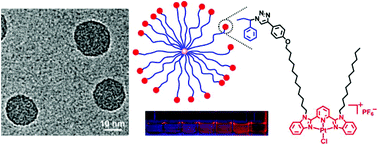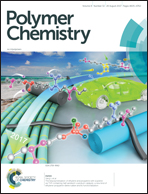Synthesis of platinum(ii) complex end functionalized star polymers: luminescence enhancements and unimolecular micelles in solvents of weakened quality†
Abstract
For the first time, two series of platinum(II) complex end functionalized star polymers have been designed and synthesized by the coordination reaction of K2PtCl4 with star polystyrene ligands ended with 2,6-bis(benzimidazol-2′-yl)pyridine. The resulting stars can self-assemble to generate spherical unimolecular micelles with a core of polystyrenes and a corona of planar platinum(II) complexes in the chloroform/methanol mixture solvent. The phosphorescence emissions of the star polymers show a stepwise increase in intensity in toluene/n-hexane or chloroform/n-hexane mixture solvents with increasing n-hexane content, where the solvent quality is gradually worsened for both the polystyrene and planar platinum(II) blocks. This class of aggregation-enhanced emissions is accordingly assigned to a triplet metal–metal-to-ligand charge-transfer excited state and has its origin in Pt⋯Pt and π–π stacking interactions that increasingly evoked between the planar platinum(II) blocks with weakening solvent quality. The star polymers terminated with high retention of luminescence metal complexes will represent a new class of functional polymer nanocomposites with well-defined topological architectures.



 Please wait while we load your content...
Please wait while we load your content...